08.19.11
Posted in books, personal at 4:19 pm by danvk
I recently finished The Power Broker, Robert Caro’s critically-acclaimed biography of New York Master Builder Robert Moses. At 1200 pages, it’s an undertaking. But I’d highly recommend it if you live in the New York area.
One passage about Moses’ daily routine struck me:
A third feature of Moses’ office was his desk. It wasn’t a desk but rather a large table. The reason was simple: Moses did not like to let problems pile up. If there was one on his desk, he wanted it disposed of immediately. Similarly, when he arrived at his desk in the morning, he disposed of the stacks of mail awaiting him by calling in secretaries and going through the stacks, letter by letter, before he went on to anything else. Having a table instead of a desk was an insurance that this procedure would be followed. Since a table has no drawers, there was no place to hide papers; there was no escape from a nagging problem or a difficult-to-answer letter except to get rid of it in one way or another. And there was another advantage: when your desk was a table, you could have conferences at it without even getting up. (p. 268)
Moses’ approach to snail mail sounds a lot like the “Getting Things Done” approach to email: make your inbox a to-do list and keep it empty. Moses wouldn’t do anything until his mail was cleared. He wouldn’t let tasks pile up, so he always had a clean plate every day. He even tailored his office to enforce this workflow.
I’ve been trying the Moses technique on my work inbox recently. When I arrive in the morning, I deal with all the emails waiting for me. No excuses. No starring and leaving the message as a “to-do” in the bottom of my inbox. There are many emails/tasks that I’d prefer to ignore, but it turns out that most of them only require ten minutes of work to deal with completely.
So far, this is working well for me. But will I be able to keep it up? Robert Moses did for forty years, so there’s hope!
Permalink
03.27.11
Posted in personal, programming, web at 2:07 pm by danvk
 It’s been almost a year since I introduced lmnowave, the collaborative crossword puzzle gadget for Google Wave. A lot has happened in that past year, not least the cancelation of Wave.
It’s been almost a year since I introduced lmnowave, the collaborative crossword puzzle gadget for Google Wave. A lot has happened in that past year, not least the cancelation of Wave.
First, to clear up some confusion. It’s not “I’m no wave”, it’s “L-M-N-O-Wave”, which is a play on “L-M-N-O-Puz”, aka lmnopuz, the software on which my collaborative crossword system is based. Only a few dozen people ever saw lmnopuz, so no one got the joke. And I realized after releasing it that, by changing ‘puz’ -> ‘wave’, I’d taken away any hint of what my wave gadget actually did. A bad name. Oh well.
In August, Google announced that Wave was canceled. This seemed to be the end of lmnowave. Sure, Wave was still usable. But the life had been sucked out of the project. This was quite disappointing to me, since I’d spent a fair bit of my own time developing the crossword gadget.
Then, in mid-December, Douwe Osinga introduced the oddly-named Google Shared Spaces. It’s an attempt to salvage the Wave gadget code, to let it live outside of Wave.
For lmnopuz, it’s perfect. Here’s the lmnowave shared space. You can use it to collaborate on crosswords with your friends, just like you could with lmnowave. In some ways, it’s even better, since the Wave UI is stripped away and you can focus on your puzzle. To do crosscountry crosswords, my friend and I open up a shared space and call each other on Skype. The combination works really well.
What does the future hold for lmnowave? It’s a bit unclear. I may turn it into a Facebook game, or perhaps use it to learn how to write applications for the Mac App store.
Enjoy!
Permalink
06.28.10
Posted in astronomy, personal, web at 6:45 pm by danvk
If you try searching for [sunrise san francisco] on Google, you’ll see a special display in the results:

This is known as a “onebox”. It’s designed to get you answers quickly. Other examples include the calculator (e.g. [2*2]), weather ([weather 94110]) and time ([time italy]) oneboxes.
The sunrise/sunset onebox is a project that I worked on in my spare time and recently launched. You can read more about it on the Official Google Blog. I first had the idea for this onebox about two years ago, so it’s very gratifying to see it finally launch!
A few features which are worth calling out:
- The sunrise and sunset times are calculated when you perform your query. They are a function of latitude, longitude and the current time. The algorithm is based on the one used by NOAA.
- In most places, you can just search for [sunrise] or [sunset] to get results for your current location. Google figures this out based on your IP.
- This onebox works on mobile phones, too, so you can search for sunset times when you’re out on a hike.
There’s a wrinkle to the sunrise/sunset calculation that non-astronomers don’t typically think about. The sun starts to behave strangely once you get north of the arctic circle or south of the antarctic circle. If you’re north of the arctic circle, then there will be at least one day during the summer when the site never sets. And there will be at least one day during the winter when it never rises. This is truly a special case for the onebox! Here’s what it looks like:
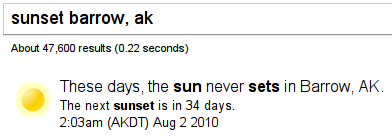
I feel bad for those Barrowans — hopefully they’ll be able to fall asleep sometime in the next 34 days!
Permalink
12.30.09
Posted in books, personal at 10:00 am by danvk
As part of my 2009 year-in-review, I tried to make a list of all the books I’d read. Give it a shot for yourself, this is hard to do! I can remember what I’ve read in the last few months, but my memory starts to fade as I get towards summer. I found a few books from the start of the year via Amazon receipts and library records, but I’m sure there are many I missed.
Here’s the list, with a few thoughts about each.
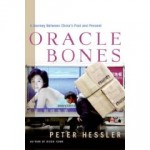 Oracle Bones, Peter Hessler
Oracle Bones, Peter Hessler
A follow-up to River Town, this book chronicles Hessler’s time in China as a journalist. Both books offer a great impression of life in China, though this one started to drag on a bit towards the end. Highlights: his discussion of the alphabetization of Chinese and his interactions with Polat, the Uighur trader who wants to emigrate to America.
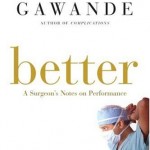 Better: A Surgeon’s Notes on Performance, Atul Gawande
Better: A Surgeon’s Notes on Performance, Atul Gawande
This book fits neatly in the “find six interesting stories and give them a catchy one-word title” genre pioneered by books like Freakonomics. But the stories here are very interesting! And the thesis is, too. In medicine (and presumably elsewhere), there are huge gains to made through non-technological means. Apgar scores reduced child mortality by making it easier to test the efficacy of treatments and changing perceptions about which babies could live. Changed expectations and the sharing of case histories had dramatic effects on the life expectancy of Cystic Fibrosis patients.
Guns, Germs, Steel, Jered Diamond
My thoughts on why this is a really bad book are documented in another blog post.
 The Botany of Desire, Michael Pollan
The Botany of Desire, Michael Pollan
As always, Michael Pollan treads that fine line between greatness and wishy-washiness. The Omnivore’s Dilemma was great. In Defense of Food was not. This book is somewhere in between. At least Michael Pollan is always honest, a welcome change after reading Jered Diamond. His researches into Johnny Appleseed were particularly fun to read. I’d never thought about this historical figure.
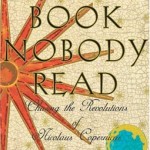 The Book Nobody Read, Owen Gingerich
The Book Nobody Read, Owen Gingerich
After reading Koestler describe Copernicus’s De Revolutionibus as “the book that nobody read”, Gingerich sets out to find every extant copy and document the marginalia — evidence of who read the book and what they thought. Part of what makes this book fun is just what a quintessential academic Gingerich is. The one thing lacking is any discussion of where Copernicus got his ideas from. This book also implicitly makes a strong argument for digitizing books: think how easy his quest would have been if he’d had search!
The watershed; a biography of Johannes Kepler, Arthur Koestler
A 250-page excerpt from the book with which Gingerich took issue. I’d always though of Kepler as the first astronomer who really “got it”. His three laws cleared away millenia of intellectual baggage. If nothing else, this book rid me of that delusion. Kepler is a really frustrating figure. He is spectacularly modern in some senses, but frustratingly medieval in others. He certainly did not consider the three laws for which we remember him his most significant contribution to science. Koestler clearly has an agenda, but I didn’t find it too distracting.
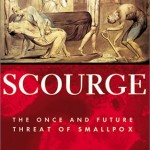 Scourge: The Once and Future Threat of Smallpox, Jonathon Tucker
Scourge: The Once and Future Threat of Smallpox, Jonathon Tucker
A really fun read. The eradication of smallpox was one of the most significant technological feats of the 20th century, and yet I’d never heard/read anything about it before. There are many great stories in the final steps towards eradication. I learned a lot about disease and pathogens from this book.
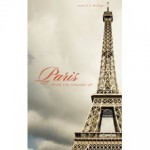 Paris from the Ground Up, James H. S. McGregor
Paris from the Ground Up, James H. S. McGregor
I read this on the way to Paris. It gave me a great sense of the city: where things were, what the significant sights were, why they were significant, etc. It follows a bizarre chronological cross thematic progression as you read which I found confusing at first, but ultimately enjoyed. If you’re going to Paris and want to have to have some context for what you’ll be seeing, this is a great book to read!
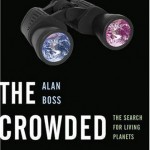 The Crowded Universe: The Search for Living Planets, Alan Boss
The Crowded Universe: The Search for Living Planets, Alan Boss
This book chronicles the hunt for extra-solar planets between 1998 and 2008, a time during which this area exploded. It reads like a blog, with dated entries any time something interesting occurred. I wrote the author and suggested he start a blog, but he didn’t want to lose the potential revenue from another book ten years from now. NASA does not come across well in this book. The trials and tribulations of what became the Kepler Mission span the whole time frame.
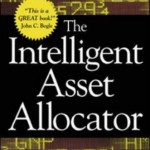 The Intelligent Asset Allocator, William Bernstein
The Intelligent Asset Allocator, William Bernstein
This is really close to the ideal personal finance book that I’d like to read. Whereas A Random Walk Down Wall Street explains why you should index, this book talks about how you should allocate assets between bonds, stocks, real estate, etc. It’s not particularly prescriptive — it won’t say “you should be 75% stocks and 25% bonds” — but at least it gives a good background on the issues involved. Basic upshot: some diversification is always a good idea.
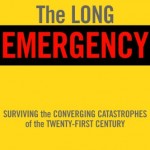 The Long Emergency, James Kunstler
The Long Emergency, James Kunstler
This book is bad, bad, bad. Kunstler’s argument is that our society is so deeply dependent on oil that, once we run out, the effects will be completely catastrophic. Large swaths of the United States will become uninhabitable. Much of modern agriculture is dependent on fossil fuel-based fertilizers, so billions of people will starve to death as earth’s carrying capacity plummets. Kunstler loves laying out doom and gloom scenarios. The problem is that he can’t be bothered to explain why they’re inevitable. There are zero charts or tables in this book, and his dismissal of technological solutions as cornucopianism is infuriating. See my thoughts on Guns, Germs, Steel for what it’s like to read a non-fiction book where you feel actively mislead.
Permalink
11.01.09
Posted in personal, sports at 1:25 pm by danvk
 I ran my first half marathon this weekend, the Healdsburg Half in scenic California wine country. The race was held on Halloween, and no small number of runners came in costume. This is a nice twist on the usual “what should I be for Halloween” dilemma. Instead, it’s “what should I be that I can sweat in for 13 miles?”
I ran my first half marathon this weekend, the Healdsburg Half in scenic California wine country. The race was held on Halloween, and no small number of runners came in costume. This is a nice twist on the usual “what should I be for Halloween” dilemma. Instead, it’s “what should I be that I can sweat in for 13 miles?”
My first goal was to finish. My second goal was to finish in under two hours. And I did! Final time was 1:54:33.1 (they are apparently very precise about these things!)
A race like this is a field day for data junkies like me, especially when you jog with an iPhone app like RunKeeper. I had it going for the first 10 miles, before my phone ran out of batteries. Here’s the track and mile splits:
| mi |
pace |
| 1 |
9:40 |
| 2 |
9:43 |
| 3 |
8:54 |
| 4 |
8:21 |
| 5 |
8:57 |
| 6 |
9:10 |
| 7 |
8:57 |
| 8 |
8:40 |
| 9 |
8:21 |
| 10 |
8:20 |
I must have picked it up after that — my pace over the remaining non-iPhone miles was 8:14/mile.
Some more stats and thoughts on what to do differently next time:
- My co-worker Jeremy suggested that a good goal for a first half marathon would be a “reverse split”: running the second half faster than the first. I did that, too! The first 6.6 miles took 61 minutes, so the second must have taken 53. I guess I should have run the first half faster!
- I should have charged my iPhone the previous night! More important than recording a track, it let me know exactly how far I’d gone: “6.34 miles” instead of “a few minutes past that six mile marker”.
- I should have brought a jacket with me to the start. The race started before dawn and it was very cold! They even transported stuff to the end of the race for the runners. Something to remember for next time.
- Running with a friend is great and can be good motivation. I ran most of the race with my friend Erica, who shaved a full 20 minutes off her previous half marathon time!
- Erica’s dentist (a former marathoner) told her that she should take a drink at every water station. This was good advice. The only drink station I skipped was the one serving wine samples!
The Healdsburg Half was very well-organized. They had full results (PDF) posted the day of the race. I finished 396/1438 overall, 234/496 amongst men and 40/76 amongst 25-29 men.
Permalink
« Previous Page — « Previous entries
Next entries » — Next Page »
 It’s been almost a year since I introduced
It’s been almost a year since I introduced 










 I ran my first half marathon this weekend, the
I ran my first half marathon this weekend, the